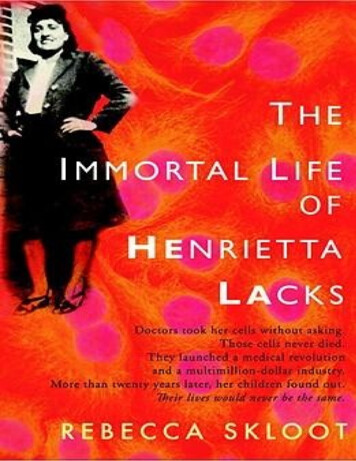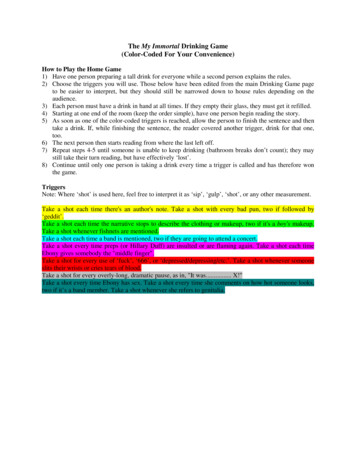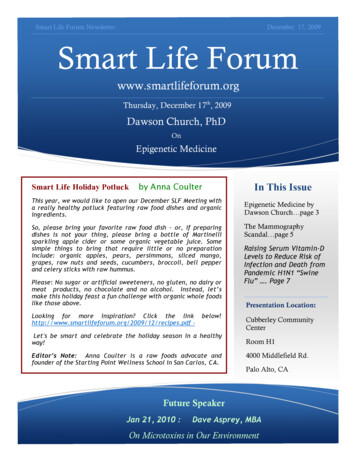
Transcription
MOREPRAISE FORThe IMMORTAL LIFE of HENRIETTA LACKS“No one can say exactly where Henrietta Lacks is buried: during the many years RebeccaSkloot spent working on this book, even Lacks’s hometown of Clover, Virginia, disappeared.But that did not stop Skloot in her quest to exhume, and resurrect, the story of her heroine andher family. What this important, invigorating book lays bare is how easily science can dowrong, especially to the poor. The issues evoked here are giant: who owns our bodies, the useand misuse of medical authority, the unhealed wounds of slavery and Skloot, with clarityand compassion, helps us take the long view. This is exactly the sort of story that bookswere made to tell—thorough, detailed, quietly passionate, and full of revelation.”—TED CONOVER, author of Newjack and The Routes of Man“It’s extremely rare when a reporter’s passion finds its match in a story. Rarer still when thepeople in that story courageously join that reporter in the search for what we most need toknow about ourselves. When this occurs with a moral journalist who is also a true writer—ahuman being with a heart capable of holding all of life’s damage and joy—the stars havealigned. This is an extraordinary gift of a book, beautiful and devastating—a work ofoutstanding literary reportage. Read it! It’s the best you will find in many, many years.”—ADRIAN NICOLE LEBLANC, author of Random Family“The Immortal Life of Henrietta Lacks brings to mind the work of Philip K. Dick and EdgarAllan Poe. But this tale is true. Rebecca Skloot explores the racism and greed, the idealism andfaith in science that helped to save thousands of lives but nearly destroyed a family. This is anextraordinary book, haunting and beautifully told.”—ERIC SCHLOSSER, author of Fast Food Nation“Rebecca Skloot has written a marvelous book so original that it defies easy description. Shetraces the surreal journey that a tiny patch of cells belonging to Henrietta Lacks’s body took tothe forefront of science. At the same time, she tells the story of Lacks and her family—wrestling the storms of the late twentieth century in America—with rich detail, wit, andhumanity. The more we read, the more we realize that these are not two separate stories, butone tapestry. It’s part The Wire, part The Lives of the Cell, and all fascinating.”—CARL ZIMMER, author of Microcosm
For my family:My parents, Betsy and Floyd; their spouses, Terry and Beverly;my brother and sister-in-law, Matt and Renee;and my wonderful nephews, Nick and Justin.They all did without me for far too long because of this book,but never stopped believing in it, or me.And in loving memory of my grandfather,James Robert Lee (1912–2003),who treasured books more than anyone I’ve known.
ContentsA Few Words About This BookPrologue: The Woman in the PhotographDeborah’s VoicePart OneLIFE1. The Exam 19512. Clover 1920–19423. Diagnosis and Treatment 19514. The Birth of HeLa 19515. “Blackness Be Spreadin All Inside” 19516. “Lady’s on the Phone” 19997. The Death and Life of Cell Culture 19518. “A Miserable Specimen” 19519. Turner Station 199910. The Other Side of the Tracks 199911. “The Devil of Pain Itself” 1951Part TwoDEATH12. The Storm 195113. The HeLa Factory 1951–195314. Helen Lane 1953–195415. “Too Young to Remember” 1951–196516. “Spending Eternity in the Same Place” 199917. Illegal, Immoral, and Deplorable 1954–196618. “Strangest Hybrid” 1960–196619. “The Most Critical Time on This Earth Is Now” 1966–197320. The HeLa Bomb 1966
21. Night Doctors 200022. “The Fame She So Richly Deserves” 1970–1973Part ThreeIMMORTALITY23. “It’s Alive” 1973–197424. “Least They Can Do” 197525. “Who Told You You Could Sell My Spleen?” 1976–198826. Breach of Privacy 1980–1985Photo Insert27. The Secret of Immortality 1984–199528. After London 1996–199929. A Village of Henriettas 200030. Zakariyya 200031. Hela, Goddess of Death 2000–200132. “All That’s My Mother” 200133. The Hospital for the Negro Insane 200134. The Medical Records 200135. Soul Cleansing 200136. Heavenly Bodies 200137. “Nothing to Be Scared About” 200138. The Long Road to Clover 2009Where They Are NowAfterwordAcknowledgmentsNotes
A Few Words About This BookThis is a work of nonfiction. No names have been changed, no charactersinvented, no events fabricated. While writing this book, I conducted more than athousand hours of interviews with family and friends of Henrietta Lacks, as wellas with lawyers, ethicists, scientists, and journalists who’ve written about theLacks family. I also relied on extensive archival photos and documents, scientificand historical research, and the personal journals of Henrietta’s daughter,Deborah Lacks.I’ve done my best to capture the language with which each person spoke andwrote: dialogue appears in native dialects; passages from diaries and otherpersonal writings are quoted exactly as written. As one of Henrietta’s relativessaid to me, “If you pretty up how people spoke and change the things they said,that’s dishonest. It’s taking away their lives, their experiences, and their selves.”In many places I’ve adopted the words interviewees used to describe theirworlds and experiences. In doing so, I’ve used the language of their times andbackgrounds, including words such as colored. Members of the Lacks familyoften referred to Johns Hopkins as “John Hopkin,” and I’ve kept their usagewhen they’re speaking. Anything written in the first person in Deborah Lacks’svoice is a quote of her speaking, edited for length and occasionally clarity.Since Henrietta Lacks died decades before I began writing this book, I reliedon interviews, legal documents, and her medical records to re-create scenes fromher life. In those scenes, dialogue is either deduced from the written record orquoted verbatim as it was recounted to me in an interview. Whenever possible Iconducted multiple interviews with multiple sources to ensure accuracy. Theextract from Henrietta’s medical record in chapter 1 is a summary of manydisparate notations.The word HeLa, used to refer to the cells grown from Henrietta Lacks’scervix, occurs throughout the book. It is pronounced hee-lah.About chronology: Dates for scientific research refer to when the research wasconducted, not when it was published. In some cases those dates are approximatebecause there is no record of exact start dates. Also, because I move back andforth between multiple stories, and scientific discoveries occur over many years,there are places in the book where, for the sake of clarity, I describe scientific
discoveries sequentially, even though they took place during the same generalperiod of time.The history of Henrietta Lacks and the HeLa cells raises important issuesregarding science, ethics, race, and class; I’ve done my best to present themclearly within the narrative of the Lacks story, and I’ve included an afterwordaddressing the current legal and ethical debate surrounding tissue ownership andresearch. There is much more to say on all the issues, but that is beyond thescope of this book, so I will leave it for scholars and experts in the field toaddress. I hope readers will forgive any omissions.
We must not see any person as an abstraction.Instead, we must see in every person a universe with its own secrets,with its own treasures, with its own sources of anguish,and with some measure of triumph.—E Wfrom The Nazi Doctors and the Nuremberg CodeLIEIESEL
PROLOGUEThe Woman in the PhotographThere’s a photo on my wall of a woman I’ve never met, its left corner tornand patched together with tape. She looks straight into the camera and smiles,hands on hips, dress suit neatly pressed, lips painted deep red. It’s the late 1940sand she hasn’t yet reached the age of thirty. Her light brown skin is smooth, hereyes still young and playful, oblivious to the tumor growing inside her—a tumorthat would leave her five children motherless and change the future of medicine.Beneath the photo, a caption says her name is “Henrietta Lacks, Helen Lane orHelen Larson.”No one knows who took that picture, but it’s appeared hundreds of times inmagazines and science textbooks, on blogs and laboratory walls. She’s usuallyidentified as Helen Lane, but often she has no name at all. She’s simply calledHeLa, the code name given to the world’s first immortal human cells—her cells,cut from her cervix just months before she died.Her real name is Henrietta Lacks.I’ve spent years staring at that photo, wondering what kind of life she led,what happened to her children, and what she’d think about cells from her cervixliving on forever—bought, sold, packaged, and shipped by the trillions tolaboratories around the world. I’ve tried to imagine how she’d feel knowing thather cells went up in the first space missions to see what would happen to humancells in zero gravity, or that they helped with some of the most importantadvances in medicine: the polio vaccine, chemotherapy, cloning, gene mapping,in vitro fertilization. I’m pretty sure that she—like most of us—would beshocked to hear that there are trillions more of her cells growing in laboratoriesnow than there ever were in her body.There’s no way of knowing exactly how many of Henrietta’s cells are alivetoday. One scientist estimates that if you could pile all HeLa cells ever grownonto a scale, they’d weigh more than 50 million metric tons—an inconceivablenumber, given that an individual cell weighs almost nothing. Another scientistcalculated that if you could lay all HeLa cells ever grown end-to-end, they’dwrap around the Earth at least three times, spanning more than 350 million feet.In her prime, Henrietta herself stood only a bit over five feet tall.
I first learned about HeLa cells and the woman behind them in 1988, thirtyseven years after her death, when I was sixteen and sitting in a communitycollege biology class. My instructor, Donald Defler, a gnomish balding man,paced at the front of the lecture hall and flipped on an overhead projector. Hepointed to two diagrams that appeared on the wall behind him. They wereschematics of the cell reproduction cycle, but to me they just looked like a neoncolored mess of arrows, squares, and circles with words I didn’t understand, like“MPF Triggering a Chain Reaction of Protein Activations.”I was a kid who’d failed freshman year at the regular public high schoolbecause she never showed up. I’d transferred to an alternative school that offereddream studies instead of biology, so I was taking Defler’s class for high-schoolcredit, which meant that I was sitting in a college lecture hall at sixteen withwords like mitosis and kinase inhibitors flying around. I was completely lost.“Do we have to memorize everything on those diagrams?” one student yelled.Yes, Defler said, we had to memorize the diagrams, and yes, they’d be on thetest, but that didn’t matter right then. What he wanted us to understand was thatcells are amazing things: There are about one hundred trillion of them in ourbodies, each so small that several thousand could fit on the period at the end ofthis sentence. They make up all our tissues—muscle, bone, blood—which in turnmake up our organs.Under the microscope, a cell looks a lot like a fried egg: It has a white (thecytoplasm) that’s full of water and proteins to keep it fed, and a yolk (thenucleus) that holds all the genetic information that makes you you. Thecytoplasm buzzes like a New York City street. It’s crammed full of moleculesand vessels endlessly shuttling enzymes and sugars from one part of the cell toanother, pumping water, nutrients, and oxygen in and out of the cell. All thewhile, little cytoplasmic factories work 24/7, cranking out sugars, fats, proteins,and energy to keep the whole thing running and feed the nucleus. The nucleus isthe brains of the operation; inside every nucleus within each cell in your body,there’s an identical copy of your entire genome. That genome tells cells when togrow and divide and makes sure they do their jobs, whether that’s controllingyour heartbeat or helping your brain understand the words on this page.Defler paced the front of the classroom telling us how mitosis—the process ofcell division—makes it possible for embryos to grow into babies, and for ourbodies to create new cells for healing wounds or replenishing blood we’ve lost.It was beautiful, he said, like a perfectly choreographed dance.All it takes is one small mistake anywhere in the division process for cells to
start growing out of control, he told us. Just one enzyme misfiring, just onewrong protein activation, and you could have cancer. Mitosis goes haywire,which is how it spreads.“We learned that by studying cancer cells in culture,” Defler said. He grinnedand spun to face the board, where he wrote two words in enormous print:HENRIETTA LACKS.Henrietta died in 1951 from a vicious case of cervical cancer, he told us. Butbefore she died, a surgeon took samples of her tumor and put them in a petridish. Scientists had been trying to keep human cells alive in culture for decades,but they all eventually died. Henrietta’s were different: they reproduced an entiregeneration every twenty-four hours, and they never stopped. They became thefirst immortal human cells ever grown in a laboratory.“Henrietta’s cells have now been living outside her body far longer than theyever lived inside it,” Defler said. If we went to almost any cell culture lab in theworld and opened its freezers, he told us, we’d probably find millions—if notbillions—of Henrietta’s cells in small vials on ice.Her cells were part of research into the genes that cause cancer and those thatsuppress it; they helped develop drugs for treating herpes, leukemia, influenza,hemophilia, and Parkinson’s disease; and they’ve been used to study lactosedigestion, sexually transmitted diseases, appendicitis, human longevity,mosquito mating, and the negative cellular effects of working in sewers. Theirchromosomes and proteins have been studied with such detail and precision thatscientists know their every quirk. Like guinea pigs and mice, Henrietta’s cellshave become the standard laboratory workhorse.“HeLa cells were one of the most important things that happened to medicinein the last hundred years,” Defler said.Then, matter-of-factly, almost as an afterthought, he said, “She was a blackwoman.” He erased her name in one fast swipe and blew the chalk from hishands. Class was over.As the other students filed out of the room, I sat thinking, That’s it? That’s allwe get? There has to be more to the story.I followed Defler to his office.“Where was she from?” I asked. “Did she know how important her cellswere? Did she have any children?”“I wish I could tell you,” he said, “but no one knows anything about her.”After class, I ran home and threw myself onto my bed with my biology
textbook. I looked up “cell culture” in the index, and there she was, a smallparenthetical:In culture, cancer cells can go on dividing indefinitely, if they have a continual supply ofnutrients, and thus are said to be “immortal.” A striking example is a cell line that has beenreproducing in culture since 1951. (Cells of this line are called HeLa cells because theiroriginal source was a tumor removed from a woman named Henrietta Lacks.)That was it. I looked up HeLa in my parents’ encyclopedia, then mydictionary: No Henrietta.As I graduated from high school and worked my way through college towarda biology degree, HeLa cells were omnipresent. I heard about them in histology,neurology, pathology; I used them in experiments on how neighboring cellscommunicate. But after Mr. Defler, no one mentioned Henrietta.When I got my first computer in the mid-nineties and started using theInternet, I searched for information about her, but found only confused snippets:most sites said her name was Helen Lane; some said she died in the thirties;others said the forties, fifties, or even sixties. Some said ovarian cancer killedher, others said breast or cervical cancer.Eventually I tracked down a few magazine articles about her from theseventies. Ebony quoted Henrietta’s husband saying, “All I remember is that shehad this disease, and right after she died they called me in the office wanting toget my permission to take a sample of some kind. I decided not to let them.” Jetsaid the family was angry—angry that Henrietta’s cells were being sold fortwenty-five dollars a vial, and angry that articles had been published about thecells without their knowledge. It said, “Pounding in the back of their heads was agnawing feeling that science and the press had taken advantage of them.”The articles all ran photos of Henrietta’s family: her oldest son sitting at hisdining room table in Baltimore, looking at a genetics textbook. Her middle sonin military uniform, smiling and holding a baby. But one picture stood out morethan any other: in it, Henrietta’s daughter, Deborah Lacks, is surrounded byfamily, everyone smiling, arms around each other, eyes bright and excited.Except Deborah. She stands in the foreground looking alone, almost as ifsomeone pasted her into the photo after the fact. She’s twenty-six years old andbeautiful, with short brown hair and catlike eyes. But those eyes glare at thecamera, hard and serious. The caption said the family had found out just a fewmonths earlier that Henrietta’s cells were still alive, yet at that point she’d beendead for twenty-five years.All of the stories mentioned that scientists had begun doing research on
Henrietta’s children, but the Lackses didn’t seem to know what that research wasfor. They said they were being tested to see if they had the cancer that killedHenrietta, but according to the reporters, scientists were studying the Lacksfamily to learn more about Henrietta’s cells. The stories quoted her sonLawrence, who wanted to know if the immortality of his mother’s cells meantthat he might live forever too. But one member of the family remained voiceless:Henrietta’s daughter, Deborah.As I worked my way through graduate school studying writing, I becamefixated on the idea of someday telling Henrietta’s story. At one point I evencalled directory assistance in Baltimore looking for Henrietta’s husband, DavidLacks, but he wasn’t listed. I had the idea that I’d write a book that was abiography of both the cells and the woman they came from—someone’sdaughter, wife, and mother.I couldn’t have imagined it then, but that phone call would mark the beginningof a decadelong adventure through scientific laboratories, hospitals, and mentalinstitutions, with a cast of characters that would include Nobel laureates, grocerystore clerks, convicted felons, and a professional con artist. While trying to makesense of the history of cell culture and the complicated ethical debatesurrounding the use of human tissues in research, I’d be accused of conspiracyand slammed into a wall both physically and metaphorically, and I’d eventuallyfind myself on the receiving end of something that looked a lot like an exorcism.I did eventually meet Deborah, who would turn out to be one of the strongestand most resilient women I’d ever known. We’d form a deep personal bond, andslowly, without realizing it, I’d become a character in her story, and she in mine.Deborah and I came from very different cultures: I grew up white and agnosticin the Pacific Northwest, my roots half New York Jew and half MidwesternProtestant; Deborah was a deeply religious black Christian from the South. Itended to leave the room when religion came up in conversation because it mademe uncomfortable; Deborah’s family tended toward preaching, faith healings,and sometimes voo doo. She grew up in a black neighborhood that was one ofthe poorest and most dangerous in the country; I grew up in a safe, quiet middleclass neighborhood in a predominantly white city and went to high school with atotal of two black students. I was a science journalist who referred to all thingssupernatural as “woo-woo stuff;” Deborah believed Henrietta’s spirit lived on inher cells, controlling the life of anyone who crossed its path. Including me.“How else do you explain why your science teacher knew her real name wheneveryone else called her Helen Lane?” Deborah would say. “She was trying toget your attention.” This thinking would apply to everything in my life: when I
married while writing this book, it was because Henrietta wanted someone totake care of me while I worked. When I divorced, it was because she’d decidedhe was getting in the way of the book. When an editor who insisted I take theLacks family out of the book was injured in a mysterious accident, Deborah saidthat’s what happens when you piss Henrietta off.The Lackses challenged everything I thought I knew about faith, science,journalism, and race. Ultimately, this book is the result. It’s not only the story ofHeLa cells and Henrietta Lacks, but of Henrietta’s family—particularly Deborah—and their lifelong struggle to make peace with the existence of those cells, andthe science that made them possible.
DEBORAH’SVOICEWhen people ask—and seems like people always be askin to where I can’t neverget away from it—I say, Yeah, that’s right, my mother name was Henrietta Lacks,she died in 1951, John Hopkins took her cells and them cells are still livin today,still multiplyin, still growin and spreadin if you don’t keep em frozen. Sciencecalls her HeLa and she’s all over the world in medical facilities, in all thecomputers and the Internet everywhere.When I go to the doctor for my checkups I always say my mother was HeLa.They get all excited, tell me stuff like how her cells helped make my bloodpressure medicines and antidepression pills and how all this important stuff inscience happen cause of her. But they don’t never explain more than just sayin,Yeah, your mother was on the moon, she been in nuclear bombs and made thatpolio vaccine. I really don’t know how she did all that, but I guess I’m glad shedid, cause that mean she helpin lots of people. I think she would like that.But I always have thought it was strange, if our mother cells done so much formedicine, how come her family can’t afford to see no doctors? Don’t make nosense. People got rich off my mother without us even knowin about them takinher cells, now we don’t get a dime. I used to get so mad about that to where itmade me sick and I had to take pills. But I don’t got it in me no more to fight. Ijust want to know who my mother was.
1The ExamOn January 29, 1951, David Lacks sat behind the wheel of his old Buick,watching the rain fall. He was parked under a towering oak tree outside JohnsHopkins Hospital with three of his children—two still in diapers—waiting fortheir mother, Henrietta. A few minutes earlier she’d jumped out of the car, pulledher jacket over her head, and scurried into the hospital, past the “colored”bathroom, the only one she was allowed to use. In the next building, under anelegant domed copper roof, a ten-and-a-half-foot marble statue of Jesus stood,arms spread wide, holding court over what was once the main entrance ofHopkins. No one in Henrietta’s family ever saw a Hopkins doctor withoutvisiting the Jesus statue, laying flowers at his feet, saying a prayer, and rubbinghis big toe for good luck. But that day Henrietta didn’t stop.She went straight to the waiting room of the gynecology clinic, a wide-openspace, empty but for rows of long straight-backed benches that looked likechurch pews.“I got a knot on my womb,” she told the receptionist. “The doctor need tohave a look.”For more than a year Henrietta had been telling her closest girlfriendssomething didn’t feel right. One night after dinner, she sat on her bed with hercousins Margaret and Sadie and told them, “I got a knot inside me.”“A what?” Sadie asked.“A knot,” she said. “It hurt somethin awful—when that man want to get with
me, Sweet Jesus aren’t them but some pains.”When sex first started hurting, she thought it had something to do with babyDeborah, who she’d just given birth to a few weeks earlier, or the bad bloodDavid sometimes brought home after nights with other women—the kinddoctors treated with shots of penicillin and heavy metals.Henrietta grabbed her cousins’ hands one at a time and guided them to herbelly, just as she’d done when Deborah started kicking.“You feel anything?”The cousins pressed their fingers into her stomach again and again.“I don’t know,” Sadie said. “Maybe you’re pregnant outside your womb—youknow that can happen.”“I’m no kind of pregnant,” Henrietta said. “It’s a knot.”“Hennie, you gotta check that out. What if it’s somethin bad?”But Henrietta didn’t go to the doctor, and the cousins didn’t tell anyone whatshe’d said in the bedroom. In those days, people didn’t talk about things likecancer, but Sadie always figured Henrietta kept it secret because she was afraid adoctor would take her womb and make her stop having children.About a week after telling her cousins she thought something was wrong, atthe age of twenty-nine, Henrietta turned up pregnant with Joe, her fifth child.Sadie and Margaret told Henrietta that the pain probably had something to dowith a baby after all. But Henrietta still said no.“It was there before the baby,” she told them. “It’s somethin else.”They all stopped talking about the knot, and no one told Henrietta’s husbandDavid anything about it. Then, four and a half months after baby Joseph wasborn, Henrietta went to the bathroom and found blood spotting her underwearwhen it wasn’t her time of the month.She filled her bathtub, lowered herself into the warm water, and slowly spreadher legs. With the door closed to her children, husband, and cousins, Henriettaslid a finger inside herself and rubbed it across her cervix until she found whatshe somehow knew she’d find: a hard lump, deep inside, as though someone hadlodged a marble just to the left of the opening to her womb.Henrietta climbed out of the bathtub, dried herself off, and dressed. Then shetold her husband, “You better take me to the doctor. I’m bleedin and it ain’t mytime.”Her local doctor took one look inside her, saw the lump, and figured it was a
sore from syphilis. But the lump tested negative for syphilis, so he told Henriettashe’d better go to the Johns Hopkins gynecology clinic.Hopkins was one of the top hospitals in the country. It was built in 1889 as acharity hospital for the sick and poor, and it covered more than a dozen acreswhere a cemetery and insane asylum once sat in East Baltimore. The publicwards at Hopkins were filled with patients, most of them black and unable to paytheir medical bills. David drove Henrietta nearly twenty miles to get there, notbecause they preferred it, but because it was the only major hospital for milesthat treated black patients. This was the era of Jim Crow—when black peopleshowed up at white-only hospitals, the staff was likely to send them away, evenif it meant they might die in the parking lot. Even Hopkins, which did treat blackpatients, segregated them in colored wards, and had colored-only fountains.So when the nurse called Henrietta from the waiting room, she led her througha single door to a colored-only exam room—one in a long row of rooms dividedby clear glass walls that let nurses see from one to the next. Henrietta undressed,wrapped herself in a starched white hospital gown, and lay down on a woodenexam table, waiting for Howard Jones, the gynecologist on duty. Jones was thinand graying, his deep voice softened by a faint Southern accent. When hewalked into the room, Henrietta told him about the lump. Before examining her,he flipped through her chart—a quick sketch of her life, and a litany of untreatedconditions:Sixth or seventh grade education; housewife and mother of five. Breathing difficult sincechildhood due to recurrent throat infections and deviated septum in patient’s nose. Physicianrecommended surgical repair. Patient declined. Patient had one toothache for nearly five years;tooth eventually extracted with several others. Only anxiety is oldest daughter who is epilepticand can’t talk. Happy household. Very occasional drinker. Has not traveled. Well nourished,cooperative. Patient was one of ten siblings. One died of car accident, one from rheumaticheart, one was poisoned. Unexplained vaginal bleeding and blood in urine during last twopregnancies; physician recommended sickle cell test. Patient declined. Been with husbandsince age 15 and has no liking for sexual intercourse. Patient has asymptomatic neuro syphilisbut cancelled syphilis treatments, said she felt fine. Two months prior to current visit, afterdelivery of fifth child, patient had significant blood in urine. Tests showed areas of increasedcellular activity in the cervix. Physician recommended diagnostics and referred to specialistfor ruling out infection or cancer. Patient canceled appointment. One month prior to currentvisit, patient tested positive for gonorrhea. Patient recalled to clinic for treatment. No response.It was no surprise that she hadn’t come back all those times for follow-up. ForHenrietta, walking into Hopkins was like entering a foreign country where shedidn’t speak the language. She knew about harvesting tobacco and butchering apig, but she’d never heard the words cervix or biopsy. She didn’t read or writemuch, and she hadn’t studied science in school. She, like most black patients,only went to Hopkins when she thought she had no choice.
Jones listened as Henrietta told him about the pain, the blood. “She says thatshe knew there was something wrong with the neck of her womb,” he wrotelater. “When asked why she knew it, she said that she felt as if there were a lumpthere. I do not quite know what she means by this, unless she actually palpatedthis area.”Henrietta lay back on the table, feet pressed hard in stirrups as she stared atthe ceiling. And sure enough, Jones found a lump exactly where she’d said hewould. He des
27. The Secret of Immortality 1984–1995 28. After London 1996–1999 29. A Village of Henriettas 2000 30. Zakariyya 2000 31. Hela, Goddess of Death 2000–2001 32. “All That’s My Mother” 2001 33. The Hospital for the Negro Insane 2001 34. The Medical











